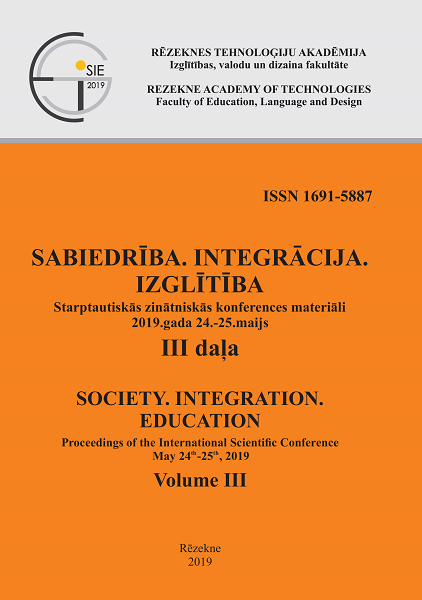PECULIARITIES OF INCLUSION OF PUPILS LIVING IN DIFFERENT CULTURAL / LINGUISTIC ENVIRONMENTS
DOI:
https://doi.org/10.17770/sie2019vol3.3903Keywords:
inclusion, different cultural/linguistic environmentsAbstract
Population mobility is expanding. Some citizens decide to leave, others return home with their families. Such mobility is reflected both in society and in the education system, so the topicality of the problem is important. According to the international classification, pupils with special educational needs include those who come to school from different cultural / linguistic backgrounds. The research question is – what are the peculiarities of the inclusive process of these students. For this purpose, 10 students and 5 teachers working with pupils from different linguistic / cultural backgrounds were interviewed in Kazakh schools. The study sought to find out what kind of support these pupils are looking for, what competences the teachers themselves want to develop. The study revealed that pupils living in a different linguistic / cultural environment who came to a general education school, expect a positive psychological climate, and want to learn the language of the country in which they live and study. Meanwhile, teachers pointed out that they did not have enough knowledge how to apply language learning methods while teaching a subject. The study revealed the identity and differences between respondents from different countries.
Downloads
References
Bijeikienė, V., & Pundziuvienė, D. (2015). IDKM diegimas Lietuvos bendrojo lavinimo mokyklose: atvejo analizė. Retriewed from https://www.thefreelibrary.com/Implementation+of+CLIL+in+Lithuanian+secondary+schools%3A+a+case...-a0421909791
Būdvytytė-Gudienė, A., Toleikienė, R., Alminienė, R., & Bikulčienė, R. (2010). Praktinės CLIL taikymo galimybės. Retriewed from http://www.esparama.lt/es_parama_pletra/failai/ESFproduktai/2010_vadovas_Praktines_CLIL_taikymo_galimybes.pdf
Janulienė, A. (2010). Apie integruoto kalbos ir dalyko dėstymą Lietuvos mokyklose. Retriewed from https://www.unifg.it/sites/default/files/allegatiparagrafo/11-02-2014/januliene_clil_at_lithuanian_schools.pdf
Martišauskienė, E. (2007). Mokytojų vertybinės nuostatos ir jų sklaida pedagoginėje veikloje. Acta Paedagogica Vilnensia, 19, 135–146.
Sercu, L. (2004). Assessing intercultural competence: A framework for systematic test development in foreign language education and beyond. Intercultural education, 15(1), 73–89.
Williams, T. R. (2009). The Reflective Model of Intercultural Competency: A Multidimensional, Qualitative Approach to Study Abroad Assessment. Frontiers: the Interdisciplinary Journal of Study Abroad, 18, 289–306.
Židžiūnienė, A. (2018). Užsieniečių vaikų ugdymas – iššūkis ar galimybė? Retriewed from http://www. svietimonaujienos.lt/uzsienieciu-vaiku-ugdymas-issukis-ar-galimybe/


